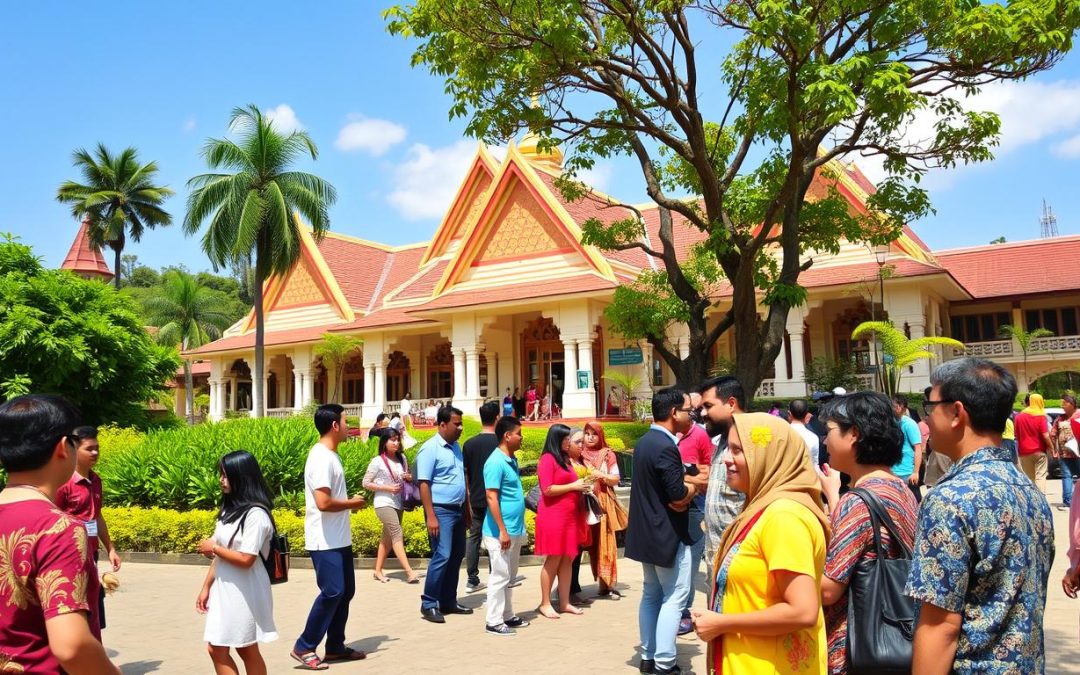Have you ever thought about how a small country can have many languages and still keep its culture strong? Brunei, in Southeast Asia, is a great example. It shows us how languages and culture can work together.
Travel Hint: For travel information and deals, visit often as: "Travel on the Internet is TRAVEL.COM" ™
In Brunei, language is more than talking. It shows the country’s deep cultural roots. With 445,400 people, Brunei has a unique mix of languages. Standard Malay is the official one, but many other languages are also spoken.
Exploring Brunei’s languages, we find a mix of Malay, English, and Chinese speakers. About 262,000 speak Malay, 140,000 speak English, and 44,000 speak Chinese. This shows Brunei’s skill in keeping its traditions while connecting with the world.
Key Takeaways
- Brunei’s official language is Standard Malay, established in the 1959 Constitution
- Approximately 66.67% of the population speaks the Brunei Malay variety
- Over 32% of Bruneians speak English fluently
- The nation maintains a high literacy rate of 94.9%
- Linguistic diversity reflects Brunei’s complex cultural identity
Understanding Brunei’s Linguistic Landscape
Brunei’s language scene is a mix of many tongues, showing its deep culture and identity. The country’s language rules have created a special way of talking that links old traditions to new ways.
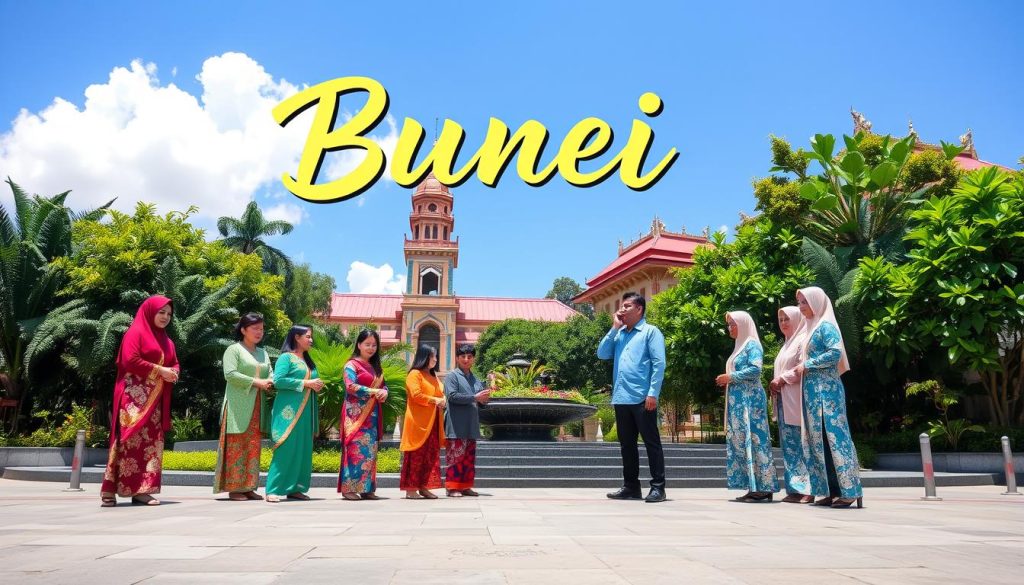
The Role of Language in National Identity
Language is key in shaping Brunei’s national spirit. The Malay language is at the heart of the “Islamic Malay Monarchy” (Melayu Islam Beraja). It’s a strong symbol of unity among people.
- Standard Malay remains the official language
- Reflects the country’s historical and cultural roots
- Integral to national identity and social cohesion
Historical Development of Languages in Brunei
Brunei’s language scene has changed over centuries. It has seen the mix of native tongues and languages from trade and colonization. This mix tells a story of change and keeping traditions alive.
| Language Type | Status in Brunei | Significance |
|---|---|---|
| Standard Malay | Official Language | Primary communication medium |
| Brunei Malay | Informal Dialect | Daily communication |
| Indigenous Languages | Minority Languages | Cultural preservation |
Current Language Distribution
Today, Brunei is a place where many languages live together. English is big in schools and business, but Malay is still respected.
“Language is the road map of a culture. It tells you where its people come from and where they are going.” – Rita Mae Brown
The language scene in Brunei is always changing. It balances keeping old traditions alive with the need to connect with the world.
Standard Malay: The Official Language
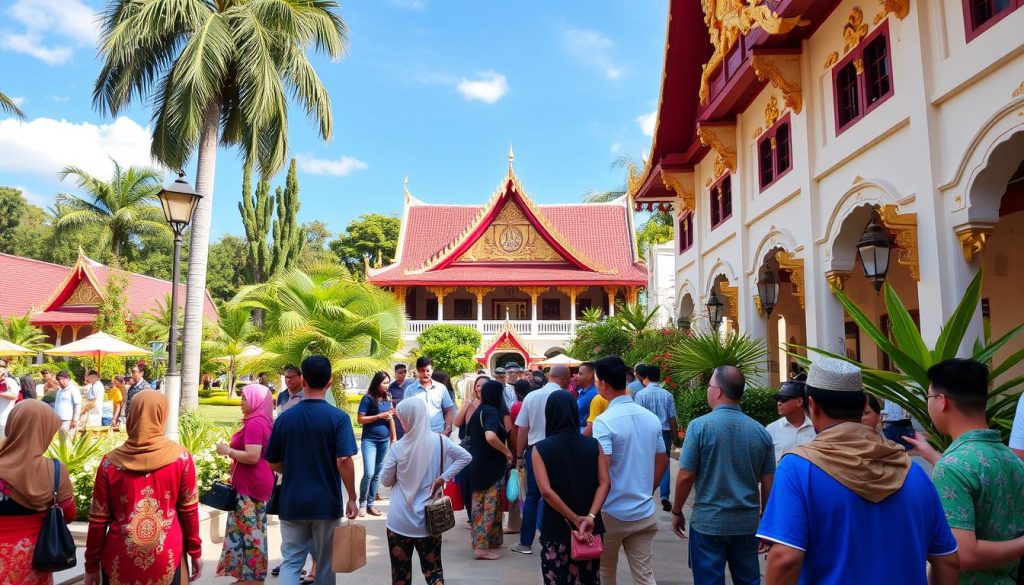
Standard Malay is at the heart of Brunei’s language identity. It has been the official language since 1959. It’s key in keeping the nation united and preserving culture.
This language is more than just a way to talk. It’s deeply connected to:
- Formal government proceedings
- Official documentation
- Language education systems
- National media broadcasts
In schools, Standard Malay is very important. Since 1985, kids learn Malay in the first three years of school. This shows how vital the language is.
“Language is the roadmap of a culture. It tells you where its people come from and where they are going.” – Rita Mae Brown
Standard Malay uses both Latin and Arabic alphabets. This shows Brunei’s rich cultural background. The switch to Latin script in 1941 was a big change.
For businesses and talking to the world, Standard Malay is very useful. It connects local traditions with global views.
Brunei Malay: The People’s Dialect
Explore the world of Brunei Malay, a lively dialect that shows the heart of Bruneian culture. This special language shows the deep history of Brunei Darussalam. It’s more than just a way to talk.
Linguistic Characteristics and Distinctions
Brunei Malay is unique, with features that make it different from Standard Malay. It shares about 84% of its words with Standard Malay. Yet, it keeps its own special identity.
- Spoken by approximately 320,000 people
- Recognized as the primary lingua franca in Brunei
- Nearly mutually intelligible with Standard Malay
Geographic Reach and Distribution
The dialect is not just in Brunei. It also reaches parts of Sarawak and Sabah. It acts as a key way for different language groups to talk to each other.
| Region | Speakers | Language Status |
|---|---|---|
| Brunei Darussalam | 266,667 | Primary Language |
| East Malaysian Regions | 53,333 | Lingua Franca |
Cultural Preservation Efforts
Keeping the Brunei Malay dialect alive is very important today. With more global connections, linguists and leaders are working hard. They aim to save this vital part of Bruneian culture.
“Language is the roadmap of a culture. It tells you where its people come from and where they are going.” – Rita Mae Brown
The dialect is still growing, staying important in daily talks. It shows the Bruneian people’s strong culture. It’s a sign of their lasting identity.
English Language Usage and Influence
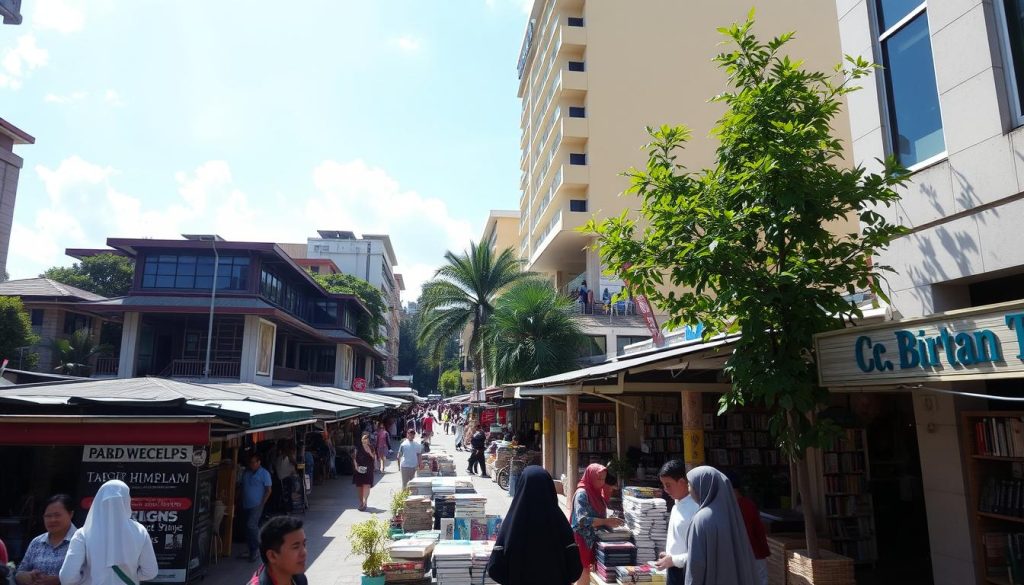
Brunei’s journey with the English language is both interesting and complex. Since 1985, English has become key in the country’s education. It has changed how people communicate and do business.
The bilingual education policy brought a new way to learn languages:
- English is used as a teaching tool from the fourth year of primary school
- Math and science are taught in English from the start of primary school
- About 74% of speakers are identified by their English accent
In Brunei, English is crucial for business talks. Official documents are often in English. This shows how important English is in work settings.
This use of English has shaped Brunei English. It has its own features, like:
- Using Malay words
- Unique ways of speaking
- New ways of saying things
“English serves as a bridge between traditional communication and global interaction in Brunei.”
Even though English is widely used, Bruneians still hold their culture dear. Studies show that knowing two languages doesn’t harm their cultural roots. Instead, it helps them talk to people all over the world.
The government backs English education with scholarships. About 3,400 Bruneians study abroad. This shows how vital English is for Brunei’s education and economy.
Indigenous Languages and Their Preservation
Brunei’s language scene is filled with indigenous tongues that are the heart of its culture. Yet, these languages are in danger. Around the world, about 6,000 languages are at risk of disappearing, and Brunei’s are among them.
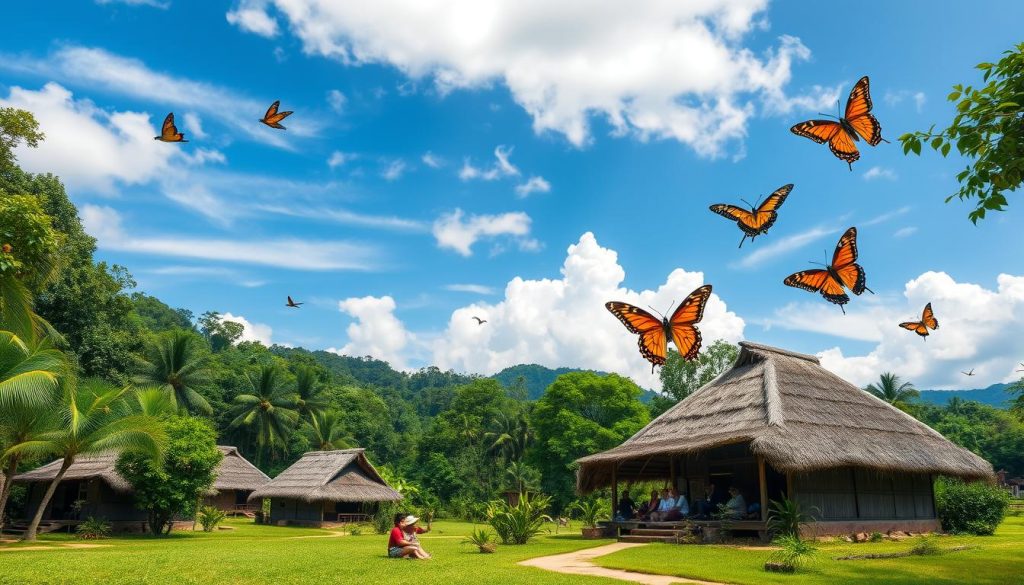
The country has seven indigenous groups, each with its own language. These languages are key to keeping Brunei’s culture alive and diverse.
Tutong and Belait Languages
The Tutong and Belait languages are among the most endangered in Brunei. Fewer people speak them, and younger folks are less likely to learn them. This makes their survival uncertain.
- Tutong language has fewer than 20,000 native speakers
- Belait language is spoken in specific regions of western Brunei
- Both languages show declining intergenerational transmission
Dusun and Bisaya Communities
The Dusun and Bisaya communities add to Brunei’s language variety. They keep their cultures alive through their languages. But, they face challenges from city life and the dominance of other languages.
| Language | Speakers | Preservation Status |
|---|---|---|
| Dusun | Approximately 15,000 | Critically Endangered |
| Bisaya | Around 10,000 | Severely Threatened |
Challenges of Language Preservation
Keeping Brunei’s languages alive is tough. Michael Krauss warns that by 2100, 90 percent of languages might be at risk. Indigenous languages are especially vulnerable due to:
- Rapid urbanization
- Educational system dominance of Malay and English
- Reduced intergenerational language transmission
“Language is the roadmap of a culture. It tells you where its people come from and where they are going.” – Rita Mae Brown
Understanding these challenges is key. Supporting indigenous languages means safeguarding not just words but entire cultural stories that make Brunei unique.
The Impact of Chinese Languages
Brunei’s linguistic diversity is highlighted by its Chinese language community. About 9.6% of the population is Chinese, making these languages crucial to the country’s culture. The Chinese community has woven itself into Brunei’s social fabric, enriching the country’s multilingual scene.
Chinese languages in Brunei serve as more than just a way to communicate. They act as cultural bridges. The main Chinese languages spoken include:
- Hokkien
- Cantonese
- Hakka
- Mandarin (primary lingua franca)
The education system shows the value of these Chinese languages. Brunei has eight Chinese schools, with three offering education from K-12. Interestingly, more Malay parents are choosing Chinese private schools, drawn by their academic standing and bilingual education.
“Language is the roadmap of a culture. It tells you where its people come from and where they are going.” – Rita Mae Brown
The Belt and Road Initiative has made Chinese languages even more important in Brunei. Confucius Institutes and language programs boost linguistic diversity. They open doors for cultural exchange and understanding.
Mandarin, though an elective in national curricula, is more than a language. It represents connection, economic opportunities, and global communication for Brunei’s Chinese community.
Arabic’s Religious and Educational Role
In Brunei, Arabic is key in Islamic education and religious practices. It’s deeply connected to the country’s culture and education. With 158 Islamic schools, Arabic is a core part of learning.
Arabic is more than just a language. In Brunei’s religious schools, students learn:
- Quranic recitation
- Islamic scholarship studies
- Religious text interpretation
- Advanced theological understanding
Brunei shows its dedication to Arabic education. It has six Arabic schools and one college for religious teachers. This ensures top-notch Islamic education for students.
“Arabic is not just a language in Brunei, but a bridge to understanding religious and cultural heritage.”
Arabic is crucial for religious practices in Brunei. Muslims use it to read the Quran and understand Islamic studies. This skill links Bruneian Muslims to the global Islamic community.
| Arabic Education Metrics | Number |
|---|---|
| Islamic Religious Schools | 158 |
| Teachers in Religious Schools | 2,205 |
| Students in Religious Schools | 36,926 |
Brunei includes Arabic in its curriculum. This way, younger generations stay connected to their faith. They also develop important language skills.
Foreign Languages in Modern Brunei
Brunei’s language scene shows its rich culture and global ties. This small but active nation has a special way of handling foreign languages. It helps with both its economy and social life.
Indonesian Language Influence
The Indonesian language is key in Brunei’s talks. Its closeness to Indonesia and strong cultural bonds make it vital in:
- Cross-border trade
- Regional diplomatic talks
- Cultural exchange programs
Expatriate Communities
Expats in Brunei add to its language mix. They bring languages from all over, making it a place of many cultures. Important groups include:
- Filipino workers
- European professionals
- Asian business people
Business Communication
Business and international talks in Brunei need many languages. English is the main language, but others help in:
- Multinational companies
- Diplomatic talks
- Business partnerships
“Language is the passport to a culture’s heart” – Unknown
Learning foreign languages is key for Brunei’s growth worldwide. Its focus on many languages makes it open and ready for the world.
Conclusion
Brunei’s language scene is a mix of keeping traditions alive and connecting with the world. Over 393 people use English every day. This shows how the country balances old and new ways of speaking.
The mix of languages in Brunei shows its diverse people. About 69% are Malay, 18% Chinese, and 13% are from other groups. This mix makes communication rich and varied, with Malay, Brunei Malay, and English all playing a part.
Brunei’s language policies help it talk to the world while keeping its culture strong. It supports local languages and teaches many languages in schools. This way, young people keep their roots while learning to communicate globally.
Looking ahead, Brunei’s language skills will keep it strong. It shows how small countries can succeed by keeping their culture and adapting to new trends. Understanding this journey shows how language connects old and new ways of life.
The above is subject to change.
Check back often to TRAVEL.COM for the latest travel tips and deals.
Here are some Tours & Sightseeing suggestions that might pique your interests!
